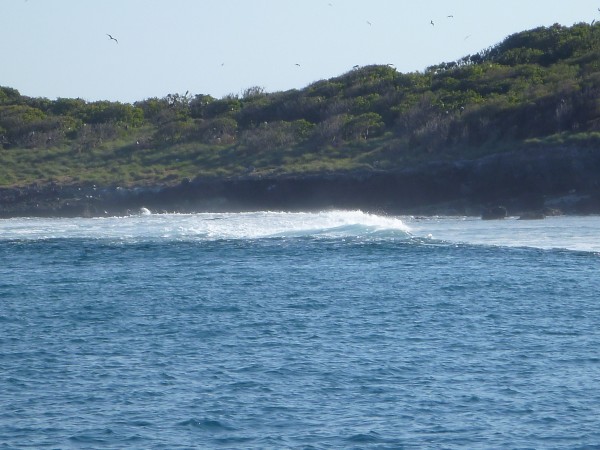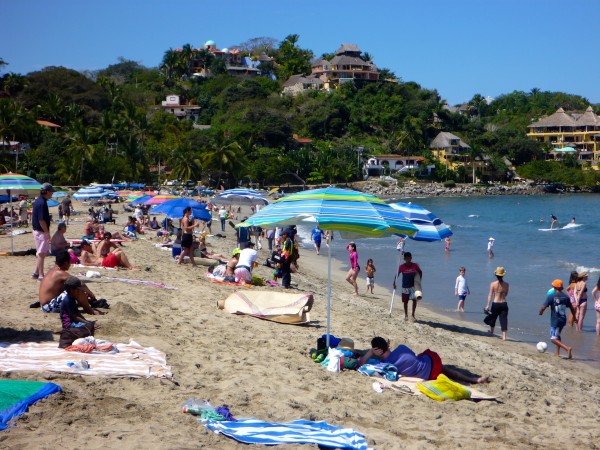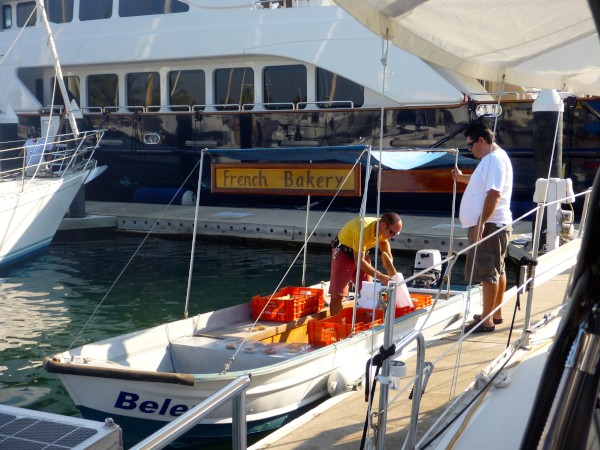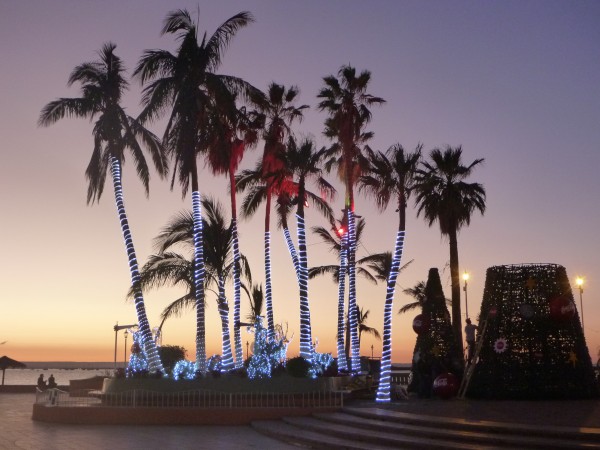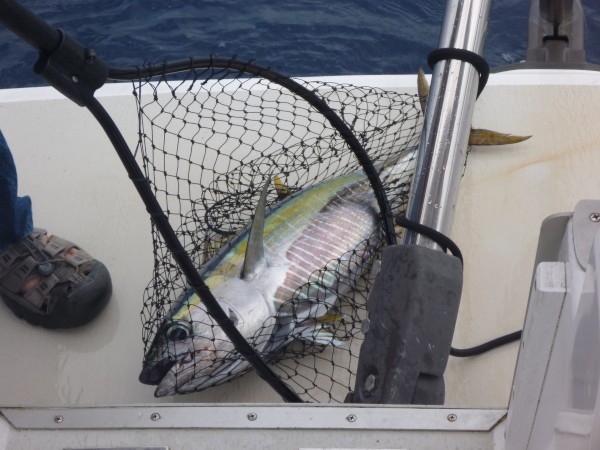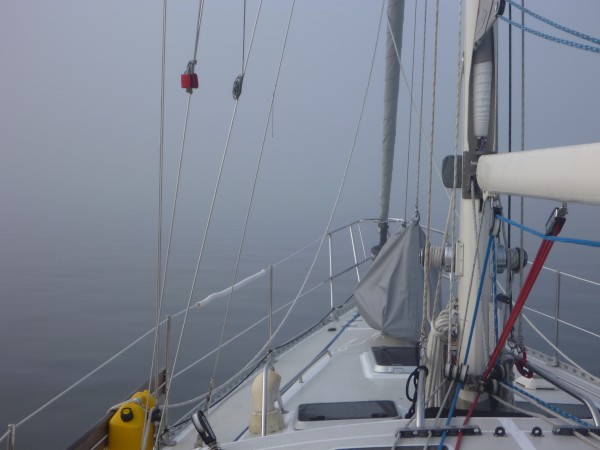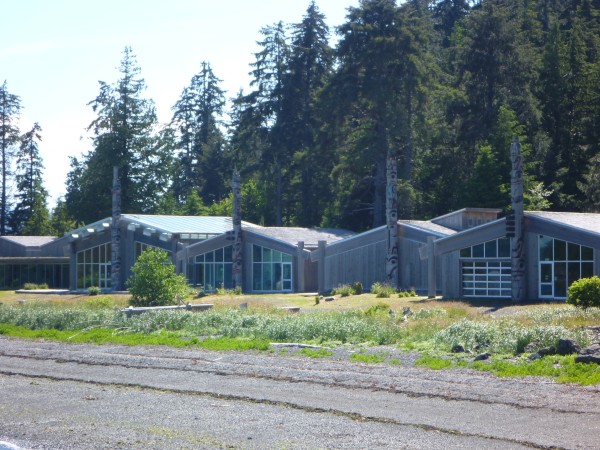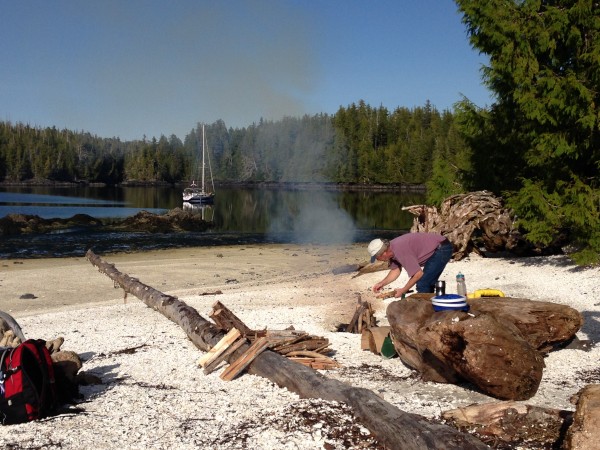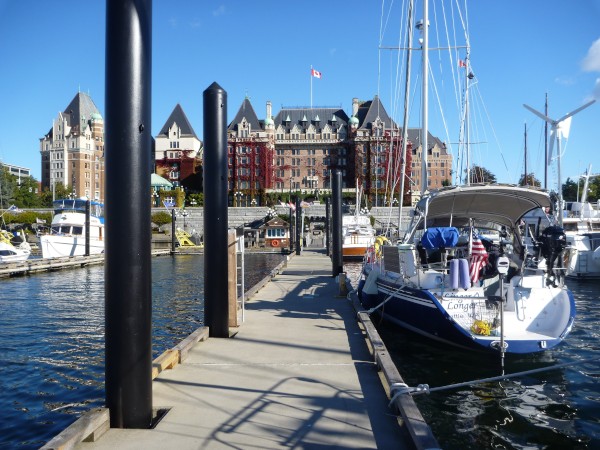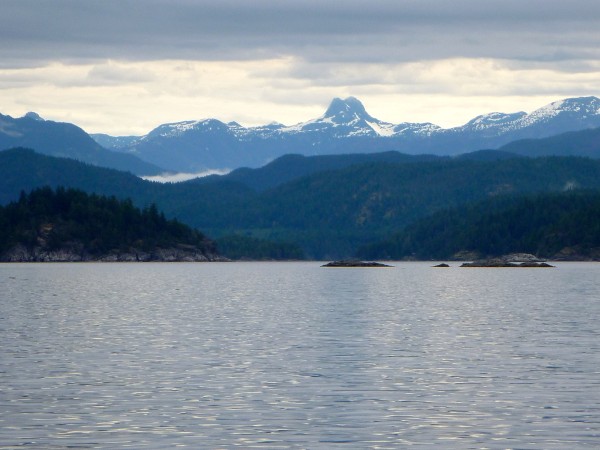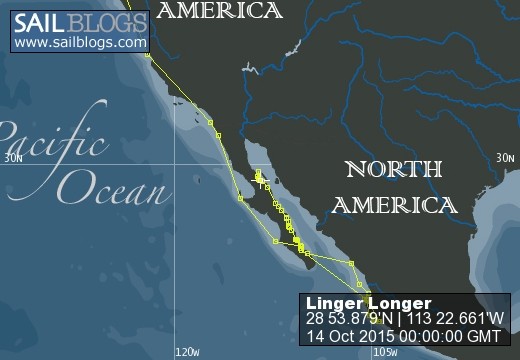
Linger Longer
14 September 2016
06 August 2016
09 July 2016
19 March 2016
19 December 2015
18 December 2015
18 December 2015
03 November 2015
18 July 2015
24 May 2015
04 April 2015
31 March 2015
26 February 2015
15 February 2015 | Barra de Navidad
07 February 2015 | Tenacatita Bay
04 February 2015
26 January 2015 | 19 18.051'N
04 January 2015 | La Cruz, Nayarit, Mexico
25 December 2014 | La Paz, Baja California Sur, Mexico
01 December 2014 | Ensenada, Mexico
Reflections by Kirk
13 August 2013
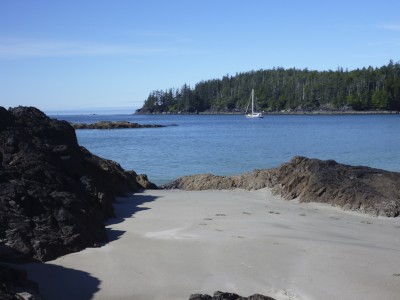
Reflections by Kirk 08-13-2013
Anchorages. What makes a good one and what makes an excellent one. First and foremost an anchorage must provide one with a sense of safety and security. You need to be able to sleep at night with confidence that the boat will be in the same place in the morning when you awaken. As mentioned previously, we usually look for an anchorage that offers protection from wind and waves. There really is a little more to it than that. The bottom has to be made of a material that will allow the anchor to dig in solidly. Solid rock does not work well. Sticky mud is excellent. There needs to be enough room so that the boat can swing three hundred sixty degrees around the anchor without running into something that will make either crunching or grinding sounds. The rock lying three feet below the water surface within the swinging radius could be problematic. Nautical charts will generally provide a very good idea if a particular location will satisfy the basics of safety and security. There are few, if any, locations where someone has not tried to anchor before we got there; and, in every case for us, so far one of the several guidebooks we use has adequately described places we have considered.
We are a thirty thousand pound boat that relies on a fifty-five pound anchor and five sixteenths inch chain to keep us put. Anchors are designed to dig into the earth. That is why the bottom material is so important. It is not just a fifty-five pound lump of metal holding us in place, but the fifty-five pounds plus all of the compacted earth the anchor is pulling against. We have used our anchoring system enough to have faith in it, but realize the limitations. Once the anchor is down and we have backed up slowly until the chain is taut, we run the engine up to about half speed for a minute or so to help set the anchor deeper or to determine if it is dragging. We are now at the outside of our swinging radius. In a no wind/no current situation, once we shift into neutral, the weight of the chain will pull the boat forward until most of the chain lies flat on the bottom and then goes straight up to our anchor roller. Problems can occur in anchorages where a relatively strong current will reverse direction four times a day to correspond with two high tides and two low tides. As the boat adjusts to the new parameters and swings around to the other side of our swinging circle, the anchor also needs to pivot one hundred eighty degrees and essentially reset itself. Our anchor has always done this well, but a rock, stump, old logging cables, coral heads, etc. could make for difficulty. The big worry would be in a place not offering protection from wind and waves. A very strong wind will push the boat back enough causing the chain to lift off the bottom and become taut. Every time a large wave lifts the boat while the chain is taut, it wants to dislodge the anchor a little bit. Eventually the anchor could break out and the boat is adrift unless the anchor is able to reset itself, which is unlikely in those conditions. The preceding is for nonboaters to help you understand that anchoring and the choice of anchorages is very serious business having huge bearing on the safety of the vessel and crew. Boaters already know this or else have crashed their boats.
So all really good anchorages have suitable bottom material, adequate swinging room as well as protection from wind and waves. We have not yet tried any anchorage that does not meet the basic criteria based on our review of charts and guidebooks. But not all anchorages are created equal. Many have attributes that set them apart, some in positive ways and some otherwise. The setting is obviously a big factor. Some of our anchorages to date I have described in previous writings and may repeat myself to some extent. Fury Cove was an excellent anchorage. The view across the white shell beaches through the rocky islets across Fitz Hugh Sound to mountainous Calvert Island was stunning, especially with a sunny day and superb sunset. It will remain a very positive memory for us heightened by our time with the kayakers who shared a freshly caught Coho salmon cooked over a beach fire. Stories we heard of Orcas and Humpback whales circling the cove added to the allure. A drawback was that we had to share this wonderful place with about eight other boats.
Klaskish Basin is about one mile long and about one-quarter mile wide. The entrance is a little intimidating being very narrow with tree limbs overhanging waters edge and a few vertical walls of granite interspersed. It winds around in a lazy curve so that you cannot see into the basin from the outside and vice versa. There are tall tree-covered mountains on both sides and a wide glacier carved valley at the head into which a small river flows. It felt as though we were anchored high in a mountain lake with eagles soaring overhead and river otters cavorting around. Aside from the beauty, two things made this a special place. First, we were the only people there. Having an anchorage all alone in itself elevates the place to special status as though the spirits have deemed us worthy enough to bestow a special favor upon us. The spying eyes of eagles, deer, seals, otters, wolves, bear or cougar don’t care if our hair is not combed, our clothes are not stylish or whether we are even clothed. We tend to be quieter in such places wanting to soak up the sounds of nature. The second reason this place was special was the small river. We paddled the kayaks about a mile up the river until a logjam of massive fallen trees blocked the way. One can only imagine the violence of the event that caused these giants up to six feet in diameter to have been transported to this place and end up all tangled together. At the base of the jam were a few small gravel bars where we beached the kayaks and bathed in the clean, clear fresh water of adjacent shallow pools, air-drying in the sun and light breeze. Superb.
Wildlife has made other places special. Laura Cove where a mama bear and two cubs visited the beach a mere thirty yards from our boat to feed on whatever they could find under the rocks. Then there is Dixie Cove where “George,” a sea otter, floated around the small cove all day and night, alternately napping, grooming and feeding. We need to make the distinction between sea otters and river otters. River otters are primarily fresh water animals that are also often seen in salt water. They have sleek, dark brown furry bodies ending in long tails with pointed ends. “Homes” are on land, sometimes under porches, crawlspaces or amongst the floats that support docks. They tend to travel in small groups and often just play around. We have seen them slide down slopes into the water only to get back up and do it again and again. Sometimes when they catch a fish they will toss it around to one another almost like a game of volleyball.
Sea Otters are really much different. They are a light golden brown color with long dense fur (the beautiful dense fur nearly lead to their extinction). Because of the fur, they appear to be rounded chubby guys with very friendly looking faces. They float around on their backs, belly and head above the water, sometimes with what appears to be a broad flattish tail and flippers curled back up onto the belly. Most of their time is spent floating around napping or grooming fur. Watching them feed is a real joy. They will dive for shellfish, sea urchins, crab and the like. When they come back up they will have a rock that is placed on the belly, which they use to break the shell of whatever they caught. Tap, tap, tap, munch, munch, munch then dive back down and do it again in a very leisurely fashion. Sea otters are laid back creatures whereas river otters almost always seem frantic with activity.
Other anchorages are special for what they have to offer on land. Goose Bay had the beautifully restored old cannery complex. The freshly painted buildings and extensive docks with only a floatplane tied to them all nestled at the base of a densely wooded hillside were a delight for the eyes. Pruth Bay offered the short hike to the wild ocean side with sandy beaches and stunning rock formations. Guise Bay at Cape Scott seemed near the end of the world. Grant Bay where we made our first “surf” landing in the dingy to walk the sandy beach and talk to the few people who camped under tarps perched atop self-styled beach log structures. Many places had dense forests all the way down hillsides right to the waters edge all around the cove. Most were old growth or at least old second growth of hemlock, spruce, red cedar and yellow cedar with a variety of understory shrubs and small trees. Many old dead or dying sentinels still stand with silvered trunks as tall spires or really big trunks with what remains of the shoots that sprang up trying to replace tops that were blown away long ago by the fierce winter winds that occur here. We have read of and heard people talk about hikes to other beaches or through the remains of old native or white settlements, but have yet to explore these places.
All is not always so wonderful. In some anchorages the insects have detracted from the overall ambiance. The constant buzzing, slapping and disposal of dead flying things over the side into the water can be bothersome. In Rock Inlet, an otherwise beautiful place, there was the floating remnant of a logging camp with weeds growing from the log floats, barrels and debris scattered about and a rusty tin roof over dilapidated buildings. In another setting this may have seemed kind of cool, but not here. It does not appear frequently, but clear cuts are like a gray brown scar with randomly scattered grey lines of decaying logs that were deemed unworthy of transport to mill. The clear cuts seem so inconsistent with the verdant hillsides of conifers with so many different shades of green that one may be tempted to think of the colors of Ireland. One of the more bothersome things is to be in an anchorage with other boaters who run the motor or a generator all day and well into the night. The constant drone of a motor is just wrong in otherwise peaceful places. Twice now we have sought extremely well protected inland anchorages to escape from the fury of predicted storms with gale force winds, heavy rain and possible thunderstorms. We ended up so well protected by high hillsides that we were unable to get VHF radio reception and lost the ability to hear weather predictions or current conditions. Oh Well.
We are not yet quite halfway down the west side of Vancouver Island and have much more to see before we find a place to settle down up here for the winter. We may have a nice spot in the inner harbor at Victoria, but have many details to work out before that can happen. Will keep you advised.
May the rains fall softly upon your fields and the sun shine warm upon your back.
Anchorages. What makes a good one and what makes an excellent one. First and foremost an anchorage must provide one with a sense of safety and security. You need to be able to sleep at night with confidence that the boat will be in the same place in the morning when you awaken. As mentioned previously, we usually look for an anchorage that offers protection from wind and waves. There really is a little more to it than that. The bottom has to be made of a material that will allow the anchor to dig in solidly. Solid rock does not work well. Sticky mud is excellent. There needs to be enough room so that the boat can swing three hundred sixty degrees around the anchor without running into something that will make either crunching or grinding sounds. The rock lying three feet below the water surface within the swinging radius could be problematic. Nautical charts will generally provide a very good idea if a particular location will satisfy the basics of safety and security. There are few, if any, locations where someone has not tried to anchor before we got there; and, in every case for us, so far one of the several guidebooks we use has adequately described places we have considered.
We are a thirty thousand pound boat that relies on a fifty-five pound anchor and five sixteenths inch chain to keep us put. Anchors are designed to dig into the earth. That is why the bottom material is so important. It is not just a fifty-five pound lump of metal holding us in place, but the fifty-five pounds plus all of the compacted earth the anchor is pulling against. We have used our anchoring system enough to have faith in it, but realize the limitations. Once the anchor is down and we have backed up slowly until the chain is taut, we run the engine up to about half speed for a minute or so to help set the anchor deeper or to determine if it is dragging. We are now at the outside of our swinging radius. In a no wind/no current situation, once we shift into neutral, the weight of the chain will pull the boat forward until most of the chain lies flat on the bottom and then goes straight up to our anchor roller. Problems can occur in anchorages where a relatively strong current will reverse direction four times a day to correspond with two high tides and two low tides. As the boat adjusts to the new parameters and swings around to the other side of our swinging circle, the anchor also needs to pivot one hundred eighty degrees and essentially reset itself. Our anchor has always done this well, but a rock, stump, old logging cables, coral heads, etc. could make for difficulty. The big worry would be in a place not offering protection from wind and waves. A very strong wind will push the boat back enough causing the chain to lift off the bottom and become taut. Every time a large wave lifts the boat while the chain is taut, it wants to dislodge the anchor a little bit. Eventually the anchor could break out and the boat is adrift unless the anchor is able to reset itself, which is unlikely in those conditions. The preceding is for nonboaters to help you understand that anchoring and the choice of anchorages is very serious business having huge bearing on the safety of the vessel and crew. Boaters already know this or else have crashed their boats.
So all really good anchorages have suitable bottom material, adequate swinging room as well as protection from wind and waves. We have not yet tried any anchorage that does not meet the basic criteria based on our review of charts and guidebooks. But not all anchorages are created equal. Many have attributes that set them apart, some in positive ways and some otherwise. The setting is obviously a big factor. Some of our anchorages to date I have described in previous writings and may repeat myself to some extent. Fury Cove was an excellent anchorage. The view across the white shell beaches through the rocky islets across Fitz Hugh Sound to mountainous Calvert Island was stunning, especially with a sunny day and superb sunset. It will remain a very positive memory for us heightened by our time with the kayakers who shared a freshly caught Coho salmon cooked over a beach fire. Stories we heard of Orcas and Humpback whales circling the cove added to the allure. A drawback was that we had to share this wonderful place with about eight other boats.
Klaskish Basin is about one mile long and about one-quarter mile wide. The entrance is a little intimidating being very narrow with tree limbs overhanging waters edge and a few vertical walls of granite interspersed. It winds around in a lazy curve so that you cannot see into the basin from the outside and vice versa. There are tall tree-covered mountains on both sides and a wide glacier carved valley at the head into which a small river flows. It felt as though we were anchored high in a mountain lake with eagles soaring overhead and river otters cavorting around. Aside from the beauty, two things made this a special place. First, we were the only people there. Having an anchorage all alone in itself elevates the place to special status as though the spirits have deemed us worthy enough to bestow a special favor upon us. The spying eyes of eagles, deer, seals, otters, wolves, bear or cougar don’t care if our hair is not combed, our clothes are not stylish or whether we are even clothed. We tend to be quieter in such places wanting to soak up the sounds of nature. The second reason this place was special was the small river. We paddled the kayaks about a mile up the river until a logjam of massive fallen trees blocked the way. One can only imagine the violence of the event that caused these giants up to six feet in diameter to have been transported to this place and end up all tangled together. At the base of the jam were a few small gravel bars where we beached the kayaks and bathed in the clean, clear fresh water of adjacent shallow pools, air-drying in the sun and light breeze. Superb.
Wildlife has made other places special. Laura Cove where a mama bear and two cubs visited the beach a mere thirty yards from our boat to feed on whatever they could find under the rocks. Then there is Dixie Cove where “George,” a sea otter, floated around the small cove all day and night, alternately napping, grooming and feeding. We need to make the distinction between sea otters and river otters. River otters are primarily fresh water animals that are also often seen in salt water. They have sleek, dark brown furry bodies ending in long tails with pointed ends. “Homes” are on land, sometimes under porches, crawlspaces or amongst the floats that support docks. They tend to travel in small groups and often just play around. We have seen them slide down slopes into the water only to get back up and do it again and again. Sometimes when they catch a fish they will toss it around to one another almost like a game of volleyball.
Sea Otters are really much different. They are a light golden brown color with long dense fur (the beautiful dense fur nearly lead to their extinction). Because of the fur, they appear to be rounded chubby guys with very friendly looking faces. They float around on their backs, belly and head above the water, sometimes with what appears to be a broad flattish tail and flippers curled back up onto the belly. Most of their time is spent floating around napping or grooming fur. Watching them feed is a real joy. They will dive for shellfish, sea urchins, crab and the like. When they come back up they will have a rock that is placed on the belly, which they use to break the shell of whatever they caught. Tap, tap, tap, munch, munch, munch then dive back down and do it again in a very leisurely fashion. Sea otters are laid back creatures whereas river otters almost always seem frantic with activity.
Other anchorages are special for what they have to offer on land. Goose Bay had the beautifully restored old cannery complex. The freshly painted buildings and extensive docks with only a floatplane tied to them all nestled at the base of a densely wooded hillside were a delight for the eyes. Pruth Bay offered the short hike to the wild ocean side with sandy beaches and stunning rock formations. Guise Bay at Cape Scott seemed near the end of the world. Grant Bay where we made our first “surf” landing in the dingy to walk the sandy beach and talk to the few people who camped under tarps perched atop self-styled beach log structures. Many places had dense forests all the way down hillsides right to the waters edge all around the cove. Most were old growth or at least old second growth of hemlock, spruce, red cedar and yellow cedar with a variety of understory shrubs and small trees. Many old dead or dying sentinels still stand with silvered trunks as tall spires or really big trunks with what remains of the shoots that sprang up trying to replace tops that were blown away long ago by the fierce winter winds that occur here. We have read of and heard people talk about hikes to other beaches or through the remains of old native or white settlements, but have yet to explore these places.
All is not always so wonderful. In some anchorages the insects have detracted from the overall ambiance. The constant buzzing, slapping and disposal of dead flying things over the side into the water can be bothersome. In Rock Inlet, an otherwise beautiful place, there was the floating remnant of a logging camp with weeds growing from the log floats, barrels and debris scattered about and a rusty tin roof over dilapidated buildings. In another setting this may have seemed kind of cool, but not here. It does not appear frequently, but clear cuts are like a gray brown scar with randomly scattered grey lines of decaying logs that were deemed unworthy of transport to mill. The clear cuts seem so inconsistent with the verdant hillsides of conifers with so many different shades of green that one may be tempted to think of the colors of Ireland. One of the more bothersome things is to be in an anchorage with other boaters who run the motor or a generator all day and well into the night. The constant drone of a motor is just wrong in otherwise peaceful places. Twice now we have sought extremely well protected inland anchorages to escape from the fury of predicted storms with gale force winds, heavy rain and possible thunderstorms. We ended up so well protected by high hillsides that we were unable to get VHF radio reception and lost the ability to hear weather predictions or current conditions. Oh Well.
We are not yet quite halfway down the west side of Vancouver Island and have much more to see before we find a place to settle down up here for the winter. We may have a nice spot in the inner harbor at Victoria, but have many details to work out before that can happen. Will keep you advised.
May the rains fall softly upon your fields and the sun shine warm upon your back.
Comments
| Vessel Name: | S/V Linger Longer |
| Vessel Make/Model: | Sceptre 41/43 |
| Hailing Port: | Seattle, WA |
| Crew: | Kirk & Kristin Doyle |
| Extra: | |
| Home Page: | http://www.k2doyle.com |
S/V Linger Longer's Photos - Main
|
Heading north into the Sea of Cortez for the summer where there is less change of hurricanes.
72 Photos
Created 19 December 2015
|
Who: Kirk & Kristin Doyle
Port: Seattle, WA
